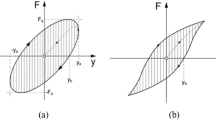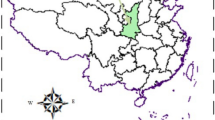Abstract
Non-destructive testing (NDT) is effective in detecting surface as well as intrinsic faults in structures during production or in-service service life without destroying the originality of the test specimen. It is a tool that ascertains the viability of potential, behind sceptically for current and future use of material. The structural strength of the coal handling plant is mitigating during its service life cycle of dispatching coal. Residual and service stresses, impact of coal, fatigue loading and corrosion due to detrimental environmental incongruities are the substantive reason behind its quality deterioration. A three-dimensional structure of the coal handling plant was made in Creo for analysing the actual load condition on the designed structures. Anomaly in between energy propagation through the test specimen is the principle of flaw detection which was generated during use. Ultrasonic flaw detection (UFD), liquid penetration test (LPT), ultrasonic thickness test (UTT), ultrasonic pulse velocity test (UPVT) and rebound hammer test (RHT) were done on the steel structure and concrete base of the coal handling plant for speculating their integrity of safety. Impediment and variation in the energy propagation are the substantive evidence of non-destructive testing predominantly. Reliability of complete structure was estimated, and expected life of bunker was ascertained for 20 years by applying Weibull distribution with the in situ NDT results.




















Similar content being viewed by others
Data Availability
The data presented in this study are available on request from the corresponding author.
References
Siddiqui, M.A.H., Agrawal, A.K., Chattopadhyaya, S.: In Situ Non-destructive Testing of Man Riding Chair Lift System. In Proceedings of International Conference in Mechanical and Energy Technology (pp. 27-39). Springer, Singapore (2020)
Kot, P.; Muradov, M.; Gkantou, M.; Kamaris, G.S.; Hashim, K.; Yeboah, D.: Recent advancements in non-destructive testing techniques for structural health monitoring. Appl. Sci. 11(6), 2750 (2021)
Raj, B.; Jayakumar, T.; Rao, B.P.C.: Non-destructive testing and evaluation for structural integrity. Sadhana 20.1, 5–38 (1995)
Dwivedi, S.K.; Vishwakarma, M.; Soni, A.: Advances and researches on non-destructive testing: A review. Mater. Today: Proc. 5(2), 3690–3698 (2018)
Degischer, H.P., Kottar, A.: On the non-destructive testing of metal foams. In: Metall Foams and Porous Metal Structures. International Conference on Metal Foams and Porous Metal Structures (1999)
Gholizadeh, S.: A review of non-destructive testing methods of composite materials. Proc. Struct. Integr. 1, 50–57 (2016)
Ginzel, E.: NDT modelling an overview. Proc. Conference on Modelling in Non-Destructive Testing, Pretoria, South Africa (2007)
Wang, B., et al.: Non-destructive testing and evaluation of composite materials/structures: A state-of-the-art review. Adv. Mech. Eng. 124, 168781402091376 (2020)
Ojha, S.: Coal handling system-its performance monitoring & suggestive measures for improvements. Diss (2015)
Padole, P.M., Joshi, M.M., Junior Engineer: Application and implementation of residual life assessment techniques for coal handling plant. NDE2002 predict. Assure. improve. National Seminar of ISNT, Chennai. 5 (2002)
Bolotina, I.O., Sednev, D.A., Portenko, V. A.: Ultrasonic testing method for quality control of mold castings. IOP Conference Series: Materials Science and Engineering. 511(1). IOP Publishing (2019)
Roshan, C.C., et al.: Non-destructive testing by liquid penetrant testing and ultrasonic testing–A review. Int. J. Adv. Res., Ideas Innov. Technol. 52, 694–697 (2019)
Mihaljević, M., et al.: Measurement uncertainty evaluation of ultrasonic wall thickness measurement. Measurement 137, 179–188 (2019)
Bogas, J.A.; Gomes, M.G.; Gomes, A.: Compressive strength evaluation of structural lightweight concrete by non-destructive ultrasonic pulse velocity method. Ultrasonics 53.5, 962–972 (2013)
Kolek, J.: An appreciation of the Schmidt rebound hammer. Mag. Concr. Res. 10(28), 27–36 (1958)
Towsyfyan, H., et al.: Successes and challenges in non-destructive testing of aircraft composite structures. Chin. J. Aeronaut. 333, 771–791 (2020)
Dominguez, N.; Gibiat, V.: Non-destructive imaging using the time domain topological energy method. Ultrasonics 50(3), 367–372 (2010)
Wang, Y.-R.; Lu, Y.-L.; Chiang, D.-L.: Adapting artificial intelligence to improve in-situ concrete compressive strength estimations in rebound hammer tests. Front. Mater. 7, 365 (2020)
Marquez, G.; Pedro, F.; Munoz, C.Q.G.: A new approach for fault detection, location and diagnosis by ultrasonic testing. Energies 13(5), 1192 (2020)
Xu, Y., et al.: Non-destructive assessment of microcracks detection in cementitious materials based on nonlinear ultrasonic modulation technique. Construct. Build. Mater. 267, 121653 (2021)
Gaith, M., et al.: Neural Network usage in structural crack detection.In: 2015 International Conference on Industrial Engineering and Operations Management (IEOM). IEEE (2015)
Anderson-Cook, C.M.: Evaluating the series or parallel structure assumption for system reliability. Qual. Eng. 21(1), 88–95 (2008)
Jagtap, H.P., et al.: RAM analysis and availability optimization of thermal power plant water circulation system using PSO. Energy Rep. 7, 1133–1153 (2021)
Kołowrocki, K.: Reliability of large systems. Encyclopedia of quantitative risk analysis and assessment 4 (2008).
Menčík, J.: Reliability of Systems. Concise reliability for engineers 33 (2016)
Ditlevsen, O.; Bjerager, P.: Methods of structural systems reliability. Struct. Saf. 3(3–4), 195–229 (1986)
Chang, M.S., et al.: Reliability analysis of mechanical component with multiple failure modes. Trans. Korean Soc. Mech. Eng. A 37(9), 1169–1174 (2013)
Gaith, M., et al.: Structural crack detection in composite materials using neural networks. (2015)
Babu, S.K., Chan, H.S.A.: Productivity & reliability study of non-destructive testing techniques for inspection of structural welds in construction industry (2016)
Achenbach, J.D.: Quantitative nondestructive evaluation. Int. J. Solids Struct. 37(1–2), 13–27 (2000)
Márquez, F.P.G., Chacón, A.M.P.: A review of non-destructive testing on wind turbines blades. Renew. Energy (2020)
Popescu, D., et al.: Fully automated liquid penetrant inspection line simulation model for increasing productivity. Int. J. Simulat. Model. 12(2), 82–93 (2013)
de Lourdes Costa, M.; Baszkin, A.: The effect of the surface free energy of pharmaceutical tablets on liquid penetration. J. Pharmacy Pharmacol. 37(7), 455–460 (1985)
Honarvar, F., et al.: Estimation of uncertainty in ultrasonic thickness gauging and improvement of measurements by signal processing. Ann. Conf. (2014)
Kalyan, T., Chandra Kishen, J.: Experimental evaluation of cracks in concrete by ultrasonic pulse velocity. Proceedings of the APCNDT (2013)
Yılmaz, T., et al.: Assessment of strength properties of cemented paste backfill by ultrasonic pulse velocity test. Ultrasonics 54.5, 1386–1394 (2014)
Al-Numan, B.S., et al.: Compressive strength formula for concrete using ultrasonic pulse velocity. Int. J. Eng. Trends Technol. (IJETT) 261, 8–13 (2015)
Saha, A.K., et al.: Non-destructive prediction of strength of concrete made by lightweight recycled aggregates and nickel slag. J. Build. Eng. 33, 101614 (2021)
Fodil, N.; Chemrouk, M.; Ammar, A.: Influence of steel reinforcement on ultrasonic pulse velocity as a non-destructive evaluation of high-performance concrete strength. Eur. J. Environ. Civ. Eng. 25(2), 281–301 (2021)
Agunwamba, J.C.; Adagba, T.: A comparative analysis of the rebound hammer and ultrasonic pulse velocity in testing concrete. Niger. J. Technol. 31(1), 31–39 (2012)
Jain, A., et al.: Combined use of non-destructive tests for assessment of strength of concrete in structure. Proc. Eng. 54, 241–251 (2013)
Al-Ameeri, A.; Al-Hussain, K.; Essa, M.: Constructing mathematical models to predict compressive strength of concrete from non-destructive testing. Int. J. Civil Eng. Technol. 4, 1–20 (2013)
Martín-del-Rio, J.J.; Canivell, J.; Falcon, R.M.: The use of non-destructive testing to evaluate the compressive strength of a lime-stabilised rammed-earth wall: Rebound index and ultrasonic pulse velocity. Construct. Build. Mater. 242, 118060 (2020)
El Masri, Y.; Rakha, T.: A scoping review of non-destructive testing (NDT) techniques in building performance diagnostic inspections. Construct. Build. Mater. 265, 120542 (2020)
Yong, T.: Extended Weibull distributions in reliability engineering. (2004)
Zhang, L., Jin, G., You, Y.: Reliability assessment for very few failure data and Weibull distribution. Math. Prob. Eng. (2019)
Acknowledgements
This work is supported with no financial assistance from any of the funding sources.
Author information
Authors and Affiliations
Corresponding authors
Ethics declarations
Conflict of interest
The authors declare no conflict of interest.
Ethical approval
This article does not contain any studies with human participants or animals performed by the author.
Rights and permissions
About this article
Cite this article
Siddiqui, M.A.H., Akhtar, S., Chattopadhyaya, S. et al. Structural Integrity–Reliability Analysis of in-use Coal Handling Plants Through Energy Dissipation Techniques of Non-Destructive Testing: A Novel Experimental Study. Arab J Sci Eng 48, 3195–3208 (2023). https://doi.org/10.1007/s13369-022-07029-4
Received:
Accepted:
Published:
Issue Date:
DOI: https://doi.org/10.1007/s13369-022-07029-4




